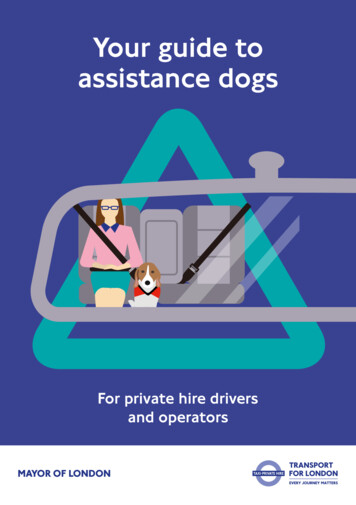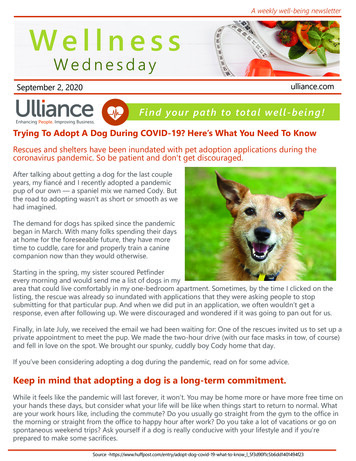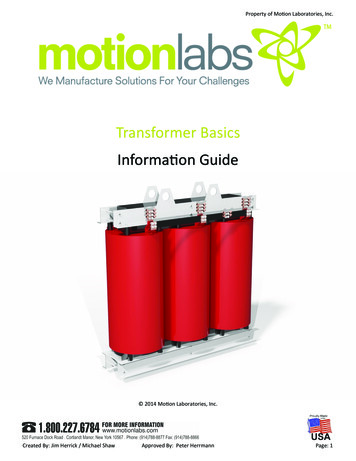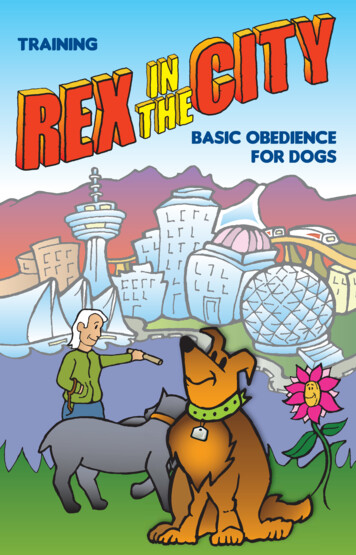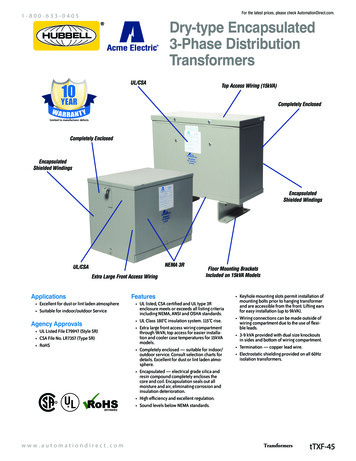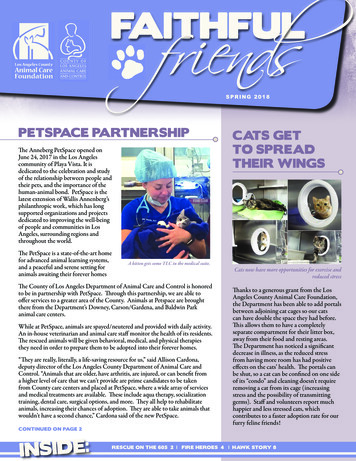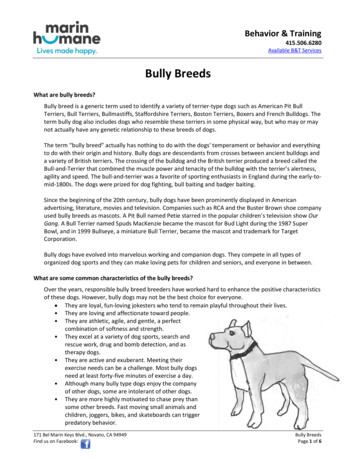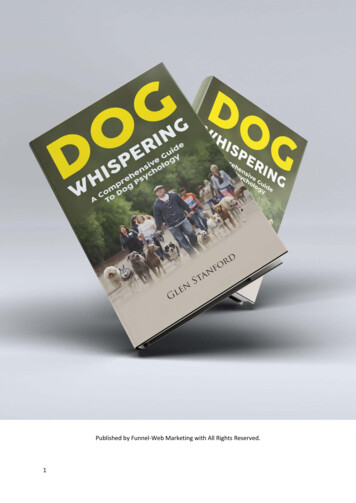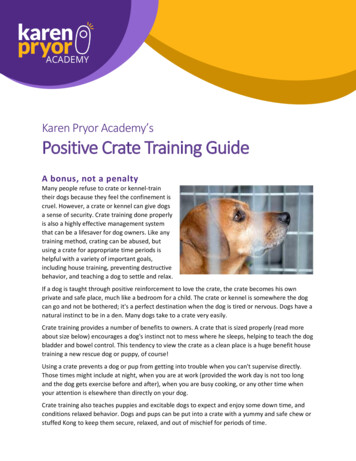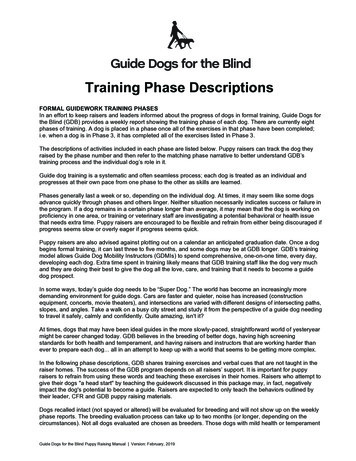
Transcription
Training Phase DescriptionsFORMAL GUIDEWORK TRAINING PHASESIn an effort to keep raisers and leaders informed about the progress of dogs in formal training, Guide Dogs forthe Blind (GDB) provides a weekly report showing the training phase of each dog. There are currently eightphases of training. A dog is placed in a phase once all of the exercises in that phase have been completed;i.e. when a dog is in Phase 3, it has completed all of the exercises listed in Phase 3.The descriptions of activities included in each phase are listed below. Puppy raisers can track the dog theyraised by the phase number and then refer to the matching phase narrative to better understand GDB’straining process and the individual dog’s role in it.Guide dog training is a systematic and often seamless process; each dog is treated as an individual andprogresses at their own pace from one phase to the other as skills are learned.Phases generally last a week or so, depending on the individual dog. At times, it may seem like some dogsadvance quickly through phases and others linger. Neither situation necessarily indicates success or failure inthe program. If a dog remains in a certain phase longer than average, it may mean that the dog is working onproficiency in one area, or training or veterinary staff are investigating a potential behavioral or health issuethat needs extra time. Puppy raisers are encouraged to be flexible and refrain from either being discouraged ifprogress seems slow or overly eager if progress seems quick.Puppy raisers are also advised against plotting out on a calendar an anticipated graduation date. Once a dogbegins formal training, it can last three to five months, and some dogs may be at GDB longer. GDB’s trainingmodel allows Guide Dog Mobility Instructors (GDMIs) to spend comprehensive, one-on-one time, every day,developing each dog. Extra time spent in training likely means that GDB training staff like the dog very muchand they are doing their best to give the dog all the love, care, and training that it needs to become a guidedog prospect.In some ways, today’s guide dog needs to be “Super Dog.” The world has become an increasingly moredemanding environment for guide dogs. Cars are faster and quieter, noise has increased (constructionequipment, concerts, movie theaters), and intersections are varied with different designs of intersecting paths,slopes, and angles. Take a walk on a busy city street and study it from the perspective of a guide dog needingto travel it safely, calmly and confidently. Quite amazing, isn't it?At times, dogs that may have been ideal guides in the more slowly-paced, straightforward world of yesteryearmight be career changed today. GDB believes in the breeding of better dogs, having high screeningstandards for both health and temperament, and having raisers and instructors that are working harder thanever to prepare each dog. all in an attempt to keep up with a world that seems to be getting more complex.In the following phase descriptions, GDB shares training exercises and verbal cues that are not taught in theraiser homes. The success of the GDB program depends on all raisers’ support. It is important for puppyraisers to refrain from using these words and teaching these exercises in their homes. Raisers who attempt togive their dogs "a head start" by teaching the guidework discussed in this package may, in fact, negativelyimpact the dog's potential to become a guide. Raisers are expected to only teach the behaviors outlined bytheir leader, CFR and GDB puppy raising materials.Dogs recalled intact (not spayed or altered) will be evaluated for breeding and will not show up on the weeklyphase reports. The breeding evaluation process can take up to two months (or longer, depending on thecircumstances). Not all dogs evaluated are chosen as breeders. Those dogs with mild health or temperamentGuide Dogs for the Blind Puppy Raising Manual Version: February, 2019
issues that preclude them from breeding stock may still be eligible for training; if so, they are then neutered orspayed and prepared for a training string.“Career change” dogs are those that are released from the program for temperament, behavioral, work orhealth reasons. GDB facilitates strategic placements of career change dogs as well as placement into loving,caring adoptive pet homes. Dogs can be career changed for many factors not in a raiser's control. A raiser'ssuccess is measured by the amount of love, effort, and time spent with their puppy, not whether the pupbecomes guide or not.Some of these dogs may be evaluated for a different formal career path such as helping someone withdiabetes, seizures or hearing deficits, being a K9 Buddy dog for a young person who is blind or visionimpaired not yet old enough to work with a guide dog, search and rescue, law enforcement, and even cancerdetection. Many other dogs go on to do more “recreational” activities such as agility, tracking, or pet therapywith their adoptive families.GDB is successful due in large part to its puppy raising volunteers. Puppy raisers socialize and teach veryimportant fundamental aspects that are the foundation for a compatible guide dog. Mature puppies come intoformal training reliable in the home, relieving on cue, responsive to obedience verbal cues, are comfortable inthe environment, and loving and trusting of people. Puppy raisers are commended for their valuablecontributions to GDB’s mission!PHASE ZERO: ARRIVAL PERIODBefore formal training begins, the new dog is introduced to the GDB kennels, campus walks and the formaltraining program.Health Screening and Kennel SocializationDuring this important transitional period, each dog receives a preliminary physical exam, performed by aCanine Welfare Training Technician (CWTT). The CWTT thoroughly inspects each dog from head to tail andchecks the nose, teeth, eyes, ears, coat, skin and feet. Any ailments, abnormalities or concerns are noted andbrought to the attention of GDB’s veterinary staff. Most dogs that enter training are in excellent condition,although some may require medication for minor ailments such as an ear or eye infection.During the first week on campus, dogs receive the following: Orthopedic x-rays A formal in-for-training physical by a GDB veterinarian An eye exam by a veterinary ophthalmology specialist An accurate weightDuring the veterinary physical examination, each dog also receives any needed vaccines based on theveterinary records submitted by puppy raisers.Once physical examinations are finished, each dog is formally assigned to a group of dogs (called a “string”)and a specific training kennel. Instructors train four dogs at a time, which enables them to get the dogs outapproximately twice a day, every day, Monday through Friday. A string can range from 8 to 16 dogs,depending on the campus, staffing capabilities and overall class matching needs.During this introductory period, each dog’s personality and manageability are evaluated to help prepareinstructors in how to motivate and teach each dog most effectively.Phase Zero normally coincides with the team of instructors returning from a session in class followed by visitsto clients in their home areas. Prior to the team’s return, CWTTs, core support instructor staff, and qualifiedvolunteers care for the new dogs helping them to adapt to the kennel environment in an engaging andpositive manner. Dogs are initially put into a kennel by themselves, which is conducive to cuddling and icecube enrichment. Once x-rays and physicals are done, dogs are often paired (“doubled”) together in a kennel.Guide Dogs for the Blind Puppy Raising Manual Version: February, 2019
Week Zero Activities Walks on campus and playtime in an enclosed grass paddock Doubling kennelmates that play well together Daily grooming Medication administration, as needed Human and dog interactive play or cuddle sessions Introduction to group community run playtime Kennel enrichment activitiesKennel enrichment is anything that stimulates the senses and puts the dogs at ease in a kennel environment.The primary focus of the CWTTs is to care for and provide kennel enrichment for the dogs. Some enrichmentactivities take place daily for every dog, other activities are done intermittently, and others still are targetedtowards specific dogs (for example, dogs that are slow to adjust to kennel life; boarding or retired guides;career change dogs, and breeding stock dogs waiting for homes). Kennel enrichment activities arecontinuously evolving and the CWTT staff is always coming up with ways to entertain and stimulate the dogs.Enrichment activities are many, including: Bones and chewable toys: food stuffed Kongs and ice cubes Hanging toys with or without food in them Plush and squeaky toys – closely monitored (not recommended for raisers or clients) Baby pools filled with water or a toy and/or playground equipment Scents: vanilla, peppermint, anise, lemon, almond, etc. sprayed in the kennel Bubbles, mirrors, wind catchers, sound machines, music T-Touch, Pilates, massage and Reiki Behavior training for dogs that need additional socialization, or for career change dogs or breeder dogs awaiting placement Exercise: walks, treadmill, enclosed grass paddocks Cuddle timeTraining staff carefully observes each new string of dogs to make sure that each dog makes as smooth anadjustment to the kennels as possible. Selected dogs may receive any additional attention in the followingareas as needed: Agility programs Extra play sessions in community run Frequent walks on campus Consistent, supervised time in offices Overnights spent supervised by training staff in the student residence Any specialized programs specific to the needs of that dog (vet care, extra time in the office, etc.)PHASE 1: FORMAL TRAINING BEGINS – ON CAMPUS AND IN TOWNFood Reward and Clicker TechniquesFood rewards are used in the GDB training program as a powerful motivation and reinforcement tool forlearning and maintaining desired behavior.Clicker training is the popular term to describe a training method that uses operant conditioning -- the animalintentionally performs a behavior in order to gain a desired reward. GDB uses clicker training as a tool forteaching various aspects of guidework and obedience responses. The clicker serves as a “marker” for theexact behavior the instructor would like to see the dog perform and repeat (e.g. targeting a curb, stair,escalator, elevator, crosswalk button, seat, etc.). It is a positive reinforcement-based system that associateshigh value rewards (food) with desired behaviors. The use of the clicker in guidework training encourages thedog to be an active participant in the learning process.Enjoyable consequences (“rewards”) and the entire reward process is called “reinforcement.” Clicker traineddogs will actively try to learn new behaviors and will remember those behaviors years later. Clicker trainedbehaviors are performed by the dog with confidence and enthusiasm because the dog plays an active roleand has control over when it receives rewards. They are enthusiastic because they understand that theirperformance will be rewarded with something very pleasurable.Guide Dogs for the Blind Puppy Raising Manual Version: February, 2019
With these training techniques, dogs in training learn faster and demonstrate higher levels of confidence inthe work, and clients experience quick and encouraging results with food use as a supplement to praise.NOTE: Unless otherwise indicated, puppy raisers do not use the clicker with their puppies. This allows dog toenter training with a ‘clean slate’ regarding clicker associations.Obedience Responses and Teaching Focus Around DistractionsIn order to both successfully teach guidework and for the client to easily manage their guide, collar responseis important. Collar response means that a dog readily follows or yields to even slight tension on the collar.For example, it is a useful tool that allows the instructor to physically cue the dog from its following position tomove left or right in guidework. Alternatively, it discourages a guide from pulling in the collar on leash with aclient.Formal ObedienceThe verbal cues “sit,” “down,” “heel” (both moving and stationary), and “stay” are introduced as precisepositions in relation to the handler. Precision is important so the dog does not interfere with or disorient theclient. The “come” recall is practiced on leash in a variety of areas and off leash in enclosed areas.Focus is taught before and during basic obedience work. Distractions are used to teach focus andconcentration toward the job. Distractions may include: other dogs, food, solicitous people, scents, and balls.Any dog that demonstrates below average ability to progress around distractions may receive additionalattention in the following areas: different types of play sessions; higher value food reward to increase thedog’s motivation to work for the handler; extra time relaxing with their instructor to develop a closerrelationship; extra abbreviated obedience sessions without distractions to improve collar response.Food Refusal ProtocolAll dogs learn how to politely accept food rewards and how to refuse food in all other situations. Thisspecialized food protocol training is designed to handle the delicate balance of using food as a motivator whileensuring that no negative behaviors develop around food. In addition, the dogs are taught how to avoid andrefuse food on the ground or offered by others.SocializationDogs are introduced to riding in the van crates prior to actually riding in the training vans. A configuration ofcrates, identical to those in the vans, is located in the kennel complex. All dogs are introduced to jumping inand out of this “mock” crate set before being put in an actual training van. Dogs then experience loading andunloading from crates in the van, riding comfortably and quietly, and waiting quietly in the van for their turn ata training route. If a dog makes a slow adjustment to the van crates, they are given additional or specializedsocialization programs.Body Handling AcceptanceDogs are exposed to comprehensive, hands-on body handling, which includes grooming and paw handling,pilling, bathing, ear and teeth cleaning, feeding, and play sessions that are conducive to interaction with ahandler who is vision- impaired (e.g. no excessive vocalization, no jumping up or running into a person). Anyissues with body handling are evaluated and programs developed to improve issues are implemented asneeded.Introduction to the HarnessDogs are given a calm introduction to being harnessed. They initially stand, then walk around in harness aswell as wear it in relaxed settings. Dogs with above average sensitivity to wearing the harness are put on asocialization program to improve their response and comfort level while wearing the harness.Treadmill TrainingTreadmill work introduces the dogs to the biomechanics of pulling into the harness and how to maintain alead. Dogs are introduced to the verbal cues of “forward,” “halt,” and “hopp-up” as they learn to pull with astraight body position. A comfortable gait and speed are identified for each dog. Most dogs adjust quickly tothe treadmill through a systematic and careful introduction, food reward use and lots of support and praise.Staff ensure the dogs are not only safe, but also enjoy their time on the treadmill. The introduction techniquesare so successful that it’s common to see dogs trying to get on the treadmill whenever they walk past one!Guide Dogs for the Blind Puppy Raising Manual Version: February, 2019
Dogs receive two treadmill sessions before beginning harness workouts (pattern training) downtown with theirinstructors.NOTE: Do not put pups on treadmills or escalators.Pattern TrainingPattern training is a method of introducing guidework behaviors to the young dog in a very positive manner.The instructor cues the correct guiding behavior to the dog, allowing the dog to complete the exercise withoutany mistakes. In this way the instructor keeps all guidework-related learning very upbeat for the dog.Obedience is used during guidework to regain attention on the work as needed. Once the dog is attentive,guidework pattern training resumes. Pattern training lasts for several sessions (approximately two weeks) andis gradually weaned off as the dog gains a better understanding of its responsibility. During pattern training,dogs are worked in a variety of environments, even challenging areas. However, advanced environments,such as heavy urban area with crowds, loud noise, etc., are avoided.Dogs are introduced to the following guidework behaviors during patterning: Stopping at streets, regardless of the type of curb or wheelchair ramp Clearing for the handler on the right and left sides as well as above dog’s head Crossing streets on a line that efficiently reaches the up curb on the other side Maintaining consistent pace and drive with the verbal cue “forward” How to respond to the various uses of the ‘hopp-up’ verbal cue – resuming or increasing pace;moving closer to a stopping point; or for re-focus Stopping and standing calmly after the verbal cue “halt” Leading the handler in a 90 degree turn to the right and picking up the new travel line on “right” Leading the handler in a 90 degree turn to the left and picking up the new travel line on “left”Up Curb Exercise #1Dogs are taught to target up curbs via clicker training and food reward by placing their front feet on the curb.The first up curb exercise is done on campus, and subsequent exercises are done on route in town.Developing Physical Agility Back Up ChuteDogs do not know how to naturally move backwards. Coordination training in how to physically backup is introduced at this time and continues for several weeks to prepare the dogs for future trafficavoidance training. In traffic avoidance, dogs are taught to speed up or stop, hold, and back up (ifneeded) in a straight line while facing the oncoming vehicle. The backup chute activity teaches dogsthe mechanics of backing up in a very positive and fun way. Obstacle CourseOn campus obstacle courses are convenient opportunities for the dog to learn how to safely navigatepast objects. The instructor patterns the dog to move past the obstacles with caution. Dogs areencouraged to walk slightly ahead of the instructor. Early on, the courses are designed so that newdogs do not need to stop on the course.PHASE 2: IN TOWN AND RESPONSIBLE LEADObedience and Distraction TrainingGeneral collar responses and formal obedience responses continue to develop. More challenging distractionsare introduced at a closer proximity, including: various dog breeds, food, solicitous people, and unusualscents.The verbal cue “over here” is introduced. This cues the dog to move from heel position, behind the handler’sback, to the right side of the handler in order to walk safely through a door that opens to the left (hinge onleft). This is also helpful when going through revolving doors and store turnstiles.Guide Dogs for the Blind Puppy Raising Manual Version: February, 2019
Body Handling AcceptanceBody handling acceptance continues to be developed and improved. Grooming, pilling, bathing, ear cleaning,teeth cleaning, feeding, and playing are done to simulate client handling. The dog is taught to lie down androll over in a variety of settings for inspection and care as needed.Kennel Adjustment and RoutineCWTTs continue to focus on kennel enrichment activities, relaxing time in community run, grooming andcampus walks. Specialized programs continue, such as kennel enrichment, harness socialization, etc.Wearing the HarnessBy now, the dogs are comfortable wearing and working in the harness. Any dogs with sensitivity to wearingthe harness are put on specialized programs.Pattern Training ProgressionInstructors now allow the dog more freedom to make decisions and make some mistakes. When errors beginto occur, instructors show the dog the correct answer before the dog gets confused. Basic level guideworkresponses are directed as a client might do. The dog experiences all guidework behaviors and the instructorstill patterns any advanced responses.Guidework responses progress to the extent that the dog can respond to each verbal cue consistently withminimal leash gestures or leash use, and maintain a straight line of travel with the instructor under blindfold.The dog learns to ignore the handler’s body position or movements, and to compensate for same as needed.Planned Dog Distraction RouteWhile everyday routes in town present natural distractions to the dogs in training, these distractions arevariable and often unpredictable. Also, not all dogs may have the opportunity to encounter that samedistraction nor have the ability to use it in a productive manner. For example, if a pet dog comes around thecorner suddenly yet also leaves suddenly, the dog in training does not have an opportunity to either make achoice to ignore the distraction or re-focus in the midst of that distraction. To afford all dogs in training theopportunity to develop this important skill, instructors work a route that includes two or three “set updistractions”– staff-held pet dogs in pre-determined areas on a route. These distractions can be seen from adistance, and the dog in training learns to remain focused both leading up to and passing the distraction.Up Curb Exercise #2The second up curb exercise is incorporated into a route in town. This exercise teaches and reinforces the“curb” verbal cue, which is used only in the street to indicate to the dog to move to the up curb as efficiently aspossible.Physical AgilityPrograms continue as in Phase 1.Obstacle Course ProgressionMost dogs are ready to guide through the clearance course, and are collar cued by the instructor to move asa finished guide might move. If not ready to work in harness, dogs continue to walk through the obstaclecourse on leash. NEW! Course design becomes more difficult, requiring more angled clearance moves by thedogs but not requiring a stop.PHASE 3: PRELIMINARY TESTINGNotable Accomplishment - Preliminary Obedience TestingFocus and responses of the following are assessed. Experienced GDMIs will assess these areasindependently, while Apprentice GDMIs will complete a formal test. Dogs are expected to understand and respond to “sit”, “down”, “heel”, “come”, and “stay” amid milddistractions with consistency and a single verbal cue Demonstration of food refusal General ease of body handlingGuide Dogs for the Blind Puppy Raising Manual Version: February, 2019
Obedience and Distraction TrainingCollar and praise responses continue to develop. Reliable responses and focus continue to develop in variousenvironments (formal, informal and during guidework). Dogs generally require minimal repeat verbal or leashcues. Instructor starts to mimic client handling more.Notable Accomplishment - Preliminary Blindfold TestingDogs must demonstrate an understanding of safe guidework skills and focus on work and handler.Experienced GDMIs will assess these skills independently during daily workouts, while Apprentice GDMIs willcomplete a formal test. The instructor works a dog under blindfold on an urban/suburban area route, adistance of approximately 8-10 blocks.Dogs that pass preliminary blindfold testing progress to advanced guidework training. Dogs that do not passor demonstrate major weaknesses in the basic fundamentals are given additional training time and are retested when ready.Difficult DistractionsContinues as in Phase 2.Body Handling AcceptanceContinues as in Phase 2.Guidework TrainingThe dogs are comfortable wearing and working in the harness. Individual dogs that still have problemswearing a harness would be a concern, but are still kept on socialization programs to improve behavior.Pattern TrainingMost dogs assume the majority of the basic responsibilities of guidework at this point and no longer needpatterning. The dogs generally respond to “forward,” and lead out and maintain drive on their own or with anoccasional leash or verbal prompt as needed. They respond to turn cues; pivot and drive out of turns; andthey maintain line during movement. Responsibility in work responses is gradually increased and tested.Responsible Lead SessionIn order to reinforce what the dog has learned, responsible lead lessons for each dog occur at the end ofpattern training. This session occurs on a long straight path. As in the planned distraction route, responsiblelead involves “set-ups” as a means to reinforce a dog’s good focus past distractions or remind a dog how toachieve the same.Up Curb Exercise #3The third up curb exercise is incorporated into a route in town.Physical Agility ProgramsContinues as in Phase 2.Sidewalkless Technique IntroductionDogs learn how to work in areas without sidewalks or a reasonable shoulder on which to walk. The travel lineis the left side of the street facing oncoming traffic. Dogs learn how to respond to intersecting streets andparked cars along their travel line.Intelligent Disobedience Training BeginsAll dogs guide in harness through a challenging obstacle clearance course with leash cues as necessary tomove as a finished guide. Course design becomes increasingly more difficult, requiring problem solving skills.Some clearances require a stop. Intelligent disobedience responses are introduced after successfulpreliminary testing. Intelligent disobedience is when a guide dog purposely does not respond to a handler’sguidework verbal cue because it is either unsafe or impossible to follow through with the response.Addressing errors is now introduced for basic clearance work. Dogs are given an opportunity to re-do the area(“re-work”) after being shown the error.Guide Dogs for the Blind Puppy Raising Manual Version: February, 2019
Obstacle Course ProgressionAll dogs guide in harness through the obstacle course with leash/collar cues as necessary. Course designbecomes more difficult, requiring even more angled clearance moves by the dogs.CWTTs continue to focus on kennel enrichment, relaxing time in community run, grooming and campuswalks.PHASE 4: BUILDING WORKFormal Harness TrainingThe dogs now have full freedom to make decisions and some mistakes with normal guidework responses.When errors occur, instructors continue to show the dog the correct answer before confusion sets in.Instructors still pattern challenging and advanced guiding decisions and responses. Dogs are worked pastopen parking lot areas and difficult travel lines to further establish responsible line stability. Working pastchallenging animal and food distractions continues.Instructors often “spot” each other (for safety), and practice short blindfold sessions with their respective dogs.This gives them valuable information regarding what guidework behaviors are strong and what need furtherdevelopment in an individual dog. Practice routes that follow these blindfold sessions focus on developmentof needed areas and reinforcement of established responses.After preliminary testing, more extensive work inside buildings begins.Body Handling AcceptanceContinues as in Phase 3. NEW! New handlers are added to assess the dog’s comfort and willingness withstrangers.Physical Agility ProgramsContinues as in Phase 3.Obstacle Course Progression ContinuesNEW! An overhead clearance is any obstacle that is above the dog’s head. Dogs are initially taught to targetthis type of clearance. The dogs are then taught to look up for overhead clearances through a graduatedapproach (teaching bar starts low, and is gradually raised as dog gains proficiency).Escalator Introductions and Training - Boarding/Riding/ExitingDogs are taught how to safely step onto moving stairs (escalators), acquire a safe stance, ride the escalatorin a stationary position, and exit safely with the appropriate energy.NOTE: Puppies are NOT to ride escalators.SocializationExtra socialization assignments are done with individual dogs as needed. Some examples: harness orsurface sensitive dogs; dogs that are reluctant to relieve on leash; or dogs that have questionable kennelbehavior that needs “proofing” or further development in a “house” (office or dorm) setting (dogs that vocalizeon tie down or crate, chewing propensities, etc.).CWTTs focus on additional relaxation sessions for all dogs as training progresses. These sessions couldinclude one or several of the following activities: community run time, kennel enrichment programs, grooming,individual play sessions, office time at staff desks, and relaxing campus walks.Guide Dogs for the Blind Puppy Raising Manual Version: February, 2019
PHASE 5: TRAFFIC TRAINING AND CITY WORKAdvanced Obedience and Distraction TrainingNew animal and common dog interest distractions (scent, cat, etc.) are sought out and responses areevaluated.Distraction interests for individual dogs are worked on separately (i.e. squirrels for some, birds for others).Advanced Guidework TrainingRoutes continue in suburban areas and may progress to downtown urban areas. Building exposure continues(stair work, elevators, tight clearance work on slick floors, etc.),Focus on improving any weak responses noted at preliminary blindfold testing and working the dogs at a paceand pull that is appropriate for a client.City Routes (San Francisco/Portland)New work areas include difficult crossings, clearances, and challenging line and curb approaches, animaldistractions, surface issues, and pedestrian islands. Heavy urban environment: crowded sidewalks, heavy/close traffic, different pedestrian climates Large government and business building work City bus rideIntensive Indoor Mall and Store Training Slower pace for more cautious work past store displays and shoppers Crowded aisles Elevators Multiple stairways (up and down) Various colors and textures of slick, shiny floors Patience is reinforced for st
the Blind (GDB) provides a weekly report showing the training phase of each dog. There are currently eight phases of training. A dog is placed in a phase once all of the exercises in that phase have been completed; i.e. when a dog is in Phase 3,
